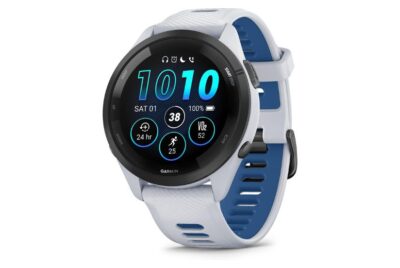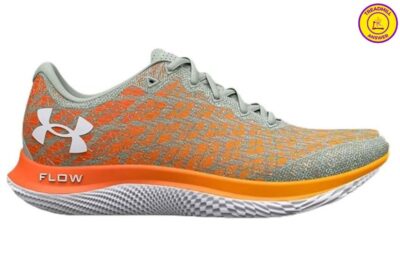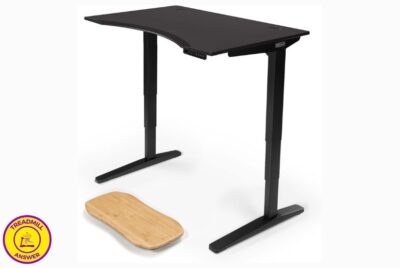Master Treadmill Pace Conversion for Optimal Workouts
When it comes to treadmill workouts, understanding your treadmill pace conversion is crucial. Whether you’re a beginner or a seasoned runner, knowing how to convert your treadmill speed into pace can help you track your progress, set goals, and achieve the best possible results.
This article will dive deep into treadmill pace conversions, offering insights into both basic and advanced charts, and showing you how to use these tools to enhance your workouts.
What is Treadmill Pace Conversion?
Pace conversion is the process of translating the speed you’re running at on a treadmill into a pace that is typically expressed in minutes per mile or kilometer. For instance, if you’re running at 6 mph, your pace is 10 minutes per mile. This simple conversion allows you to understand how fast you’re moving in a way that’s easy to relate to outdoor running metrics.
Importance of Understanding Treadmill Pace Conversion
Knowing your treadmill pace isn’t just about numbers—it’s about improving your overall fitness experience. Here’s why:
Why Runners Should Know Their Pace

Understanding your pace helps you set realistic goals, whether you’re training for a race or just trying to get in shape. If you know your pace, you can monitor improvements over time, adjust your workout intensity, and make informed decisions about your training regimen.
Benefits of Accurate Pace Tracking
Accurate pace tracking can lead to better performance. By knowing your pace, you can ensure that you’re training at the right intensity. This is especially important for avoiding burnout and injury, as you can pace yourself correctly rather than pushing too hard too soon.
Basic Treadmill Pace Conversion Chart (Flat Surface)
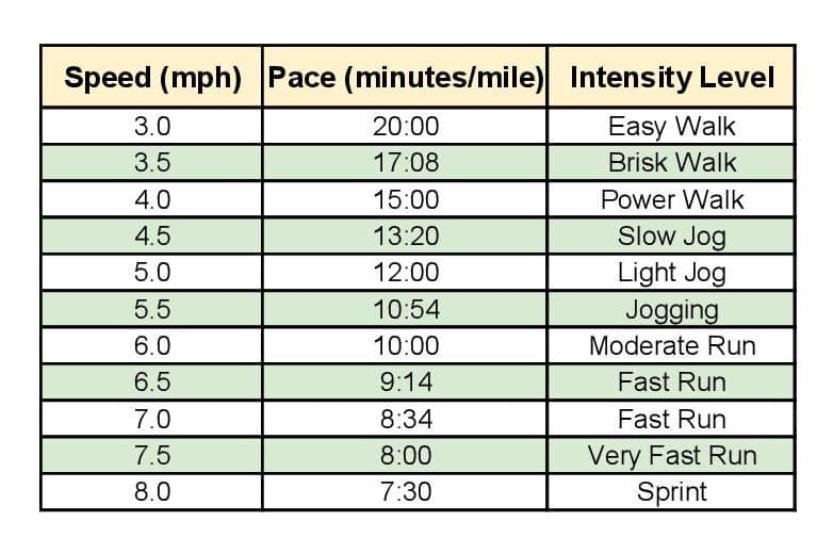
The Basic Treadmill Pace Chart provides an easy reference for understanding how speed converts to pace when running on a flat treadmill. This chart is essential for anyone who wants to track their treadmill workouts with precision.
How to Read the Treadimll Pace Conversion Chart
The chart lists speeds in miles per hour (mph) alongside the equivalent pace in minutes per mile. For example, a speed of 3 mph translates to a pace of 20 minutes per mile. This is straightforward, making it easy to use during your workouts.
Practical Uses of a Flat Surface Pace Chart
This chart is especially useful for beginners who are getting used to treadmill running. You can quickly see how changes in speed impact your pace, allowing you to experiment with different speeds until you find what’s comfortable yet challenging.
Advanced Treadmill Pace Conversion Chart (With Incline & Intensity)

For those looking to take their treadmill workouts to the next level, the Advanced Treadmill Pace Chart incorporates incline and intensity levels. This chart is more dynamic, accounting for how the treadmill’s incline affects your pace and calorie burn.
Understanding the Incline Effect on Pace
Incline significantly impacts your pace. Running at the same speed on a 6% incline is far more challenging than running on a flat surface.
The chart helps you adjust your expectations and plan your workouts accordingly. For instance, a 6 mph run on a 4% incline is equivalent to a much faster pace on a flat surface, but with the added benefit of increased calorie burn.
Matching Intensity Levels with Your Fitness Goals
This chart also categorizes intensity levels such as easy walk, brisk walk, light jog, and sprint. These categories allow you to tailor your workouts to your specific goals, whether you’re aiming for fat loss, endurance building, or speed improvement.
How to Use Pace Conversion Charts for Treadmill Workouts
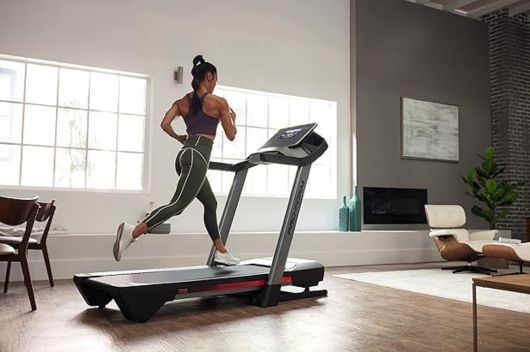
Pace charts are versatile tools that can be incorporated into a variety of treadmill workouts. Here’s how to get the most out of them:
Designing Workouts Based on Pace and Incline
You can design custom workouts by selecting specific speeds and inclines from the chart. For example, start with an easy walk at 3 mph on a flat surface for 5 minutes as a warm-up. Gradually increase to a brisk walk or light jog at a higher incline, and finish with a cooldown. This method helps ensure you’re training at the right intensity for your goals.
Monitoring Progress Using Treadmill Pace Conversions
Track your progress over time by noting your pace and how it changes as you increase your treadmill speed and incline. This can help you set and achieve new fitness goals, such as reducing your mile time or increasing your endurance.
The Role of Treadmill Pace Conversion in Fat Burning
Pace conversion isn’t just about speed—it’s also a key factor in optimizing your fat-burning workouts.
Optimizing Your Fat-Burning Zone
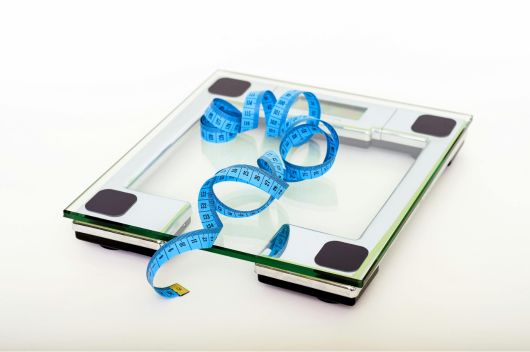
To burn fat efficiently, it’s essential to work out at the right intensity. According to the advanced pace chart, you can determine the best combination of speed and incline to stay within your fat-burning heart rate zone.
This typically involves moderate to brisk walking or light jogging at a manageable pace with a slight incline.
Sample Workouts for Effective Fat Burning
- Warm-Up: 5 minutes at 3 mph, 0% incline
- Fat-Burning Phase: 20 minutes at 4 mph, 2% incline
- Cooldown: 5 minutes at 3 mph, 0% incline
By adjusting your pace and incline based on the chart, you can maximize the calories you burn and target fat loss more effectively.
Common Mistakes to Avoid When Using Pace Conversion Charts
While pace charts are incredibly useful, there are a few common mistakes to watch out for:
Misinterpreting Pace vs. Speed
One of the most common mistakes when using treadmill pace charts is confusing pace with speed. While they might seem similar, these two metrics measure different aspects of your workout.
Speed refers to how fast you are moving at any given time, typically measured in miles per hour (mph) or kilometers per hour (km/h). On the other hand, pace is the time it takes to cover a specific distance, usually expressed in minutes per mile or kilometer.
For example, if your treadmill is set to 6 mph, this is your speed. To convert this speed into a pace, you would use a pace chart to see that 6 mph equates to a 10-minute mile pace.
Misinterpreting these terms can lead to setting unrealistic workout goals or misjudging your workout intensity, which might affect your overall performance and progress.
Ignoring the Impact of Incline on Calories Burned

Another common oversight is not considering the incline’s impact on calorie burn and workout intensity. Running or walking on an incline requires more effort, which means you burn more calories than you would on a flat surface at the same speed.
This can be significant when aiming for weight loss or improving cardiovascular fitness.
For example, walking at 4 mph on a flat surface might burn around 5 calories per minute. However, increasing the incline to 6% at the same speed can increase calorie burn to around 7-8 calories per minute.
Ignoring this can lead to underestimating the effectiveness of your workout, especially if your goal is to maximize calorie burn.
Conclusion on Treadmill Pace Conversion
Treadmill pace conversion charts are invaluable tools for anyone looking to optimize their treadmill workouts.
Whether you’re just starting or are a seasoned runner, understanding how to interpret these charts and use them to guide your workout intensity can make a significant difference in your fitness journey. From tracking progress to designing workouts that match your fitness goals, these charts help you make the most out of every treadmill session.
Frequently Asked Questions (FAQs)

What is the difference between pace and speed on a treadmill?
- Speed is how fast you’re moving, measured in mph or km/h, while pace is the time it takes to cover a distance, usually minutes per mile or kilometer.
How does incline affect calorie burn on a treadmill?
- Increasing the incline increases the effort required, which boosts calorie burn. For example, walking at 4 mph on a 6% incline burns more calories than walking at the same speed on a flat surface.
Can pace conversion charts help me improve my running time?
- Yes, by tracking your pace, you can gradually increase your speed or adjust your incline to improve your running time and overall fitness.
Is it better to walk at a fast pace or a moderate pace with an incline?
- Both are effective depending on your goals. A moderate pace with an incline can burn more calories and build endurance, while a fast pace without an incline focuses more on speed and cardiovascular fitness.
How often should I adjust my pace or incline during workouts?
- It depends on your fitness level and goals. Beginners might start with consistent settings, while more advanced users can vary their pace and incline frequently to simulate interval training and increase intensity.


